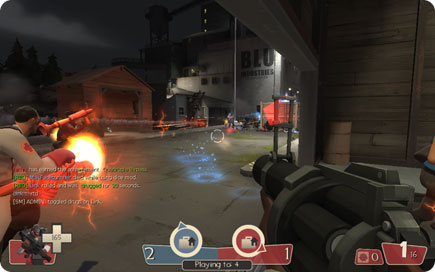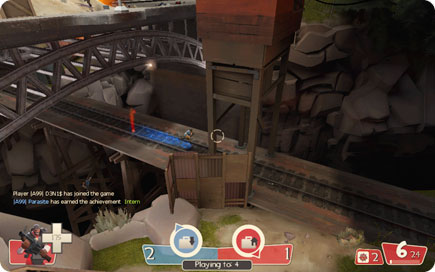
“In previous versions of Team Fortress 2, we’d adopted a realistic modern military setting,” explains Robin Walker, the game’s co-creator and project lead. “But as we worked on the gameplay, we kept butting heads with that setting. We had a Spy who could pretend to be someone else and turn invisible at will. We had Soldiers launching themselves into the air by jumping and firing their rockets into the ground at their feet.”
He continues: “All of these features needed to be given to players in a form that required the least explanation. A player should look at the embodiment of a feature and instantly understand what it does and how to use it. After months of fighting to find appropriate forms for many gameplay features we felt were too successful to cut, we threw the military setting out.

Support Function. Kukri sword in hand, a RED Sniper avenges a fallen teammate.
“Long story short, we landed on a fictional mishmash of James Bond style thrillers, where Cold War technology made everything possible — like lasers in a watch! — and a heavily stylized art direction, where characters might stop to eat a sandwich in the middle of the fight to get their health back.”
“Good art direction doesn’t just look good, it should also solve functional problems for your players”
- Robin Walker, co-creator and project lead
The Leyendecker Influence
To develop the game’s art style, Walker’s team turned to another icon who might seem out of place in an article about a first-person shooter: Norman Rockwell, who, along with such predecessors as Dean Cornwell and J.C. Leyendecker, established a specific tone for early-to-mid 20th century art. “Good art direction doesn’t just look good, it should also solve functional problems for your players,” Walker notes.

We Have a Winner! Celebrating a victory with a RED Engineer.
He cites an example of that: “A player meeting another player in the game needs to be able to rapidly extract a set of information from the in-game representation of that other player, such as ‘What team is the player on?’ ‘What class is the player?’ ‘What weapon is the player using right now?’ One of the things we’d identified in our testing was the importance of silhouettes for identification purposes: they’re color agnostic and work at extreme ranges, under widely varying lighting conditions. And it helped if the silhouettes were very clean.”

What Secrets Does BLU Industries Hide? Each map offers hints of Team Fortress 2’s tongue-in-cheek back story.
Thus Walker and his team scoured the past to develop an art style that feels fresh and cutting-edge: “We went looking for artists who’d used clean, simple silhouettes while maintaining significant amounts of detail within the silhouette shapes. J.C. Leyendecker was an artist who’d accomplished this. He also used another technique that we liked for functional reasons: he highlighted silhouette shapes with rim highlights, not dark lines. That makes a character visually stand out against the background, another important functional requirement for Team Fortress 2’s combat.”
Game Hardware
Check out our systems for your best gaming experience.
- Site: Team Fortress 2
- Publisher: Valve Software
- Developer: Valve Software
- Genre: Action
“We wanted classes that allowed players with widely varying skill sets to be able to have fun together.”
- Robin Walker, co-creator and project lead
So the next time you spot a Scout at 20 paces and fire a few sticky bombs his way, you can thank someone who passed away decades before the invention of the home computer.
So Much to Master
The Scout is one of the game’s nine distinct classes; each comes with a unique cartoonish personality. (To learn more about them, see “Division of Labor” on page two.) “We wanted much greater differentiation between classes than just damage done and damage taken,” Walker explains. “We wanted classes that allowed players with widely varying skill sets to be able to have fun together.”

Taking Aim. A BLU player thinks she’s being sneaky.
He elaborates: “So we have a class that wants to flank and hit enemies from the side, playing a combative equivalent of hit-and-run. We’ve got a class for people who want to outwit their opponent, rather than out-fight them. We have a pair of classes that love to work as a unit, so that you and a friend can play in an almost co-op style. There’s a role that’s perfect for you in Team Fortress 2, and the interactions it has with other classes is something you haven’t seen before.”
The characters’ combat abilities haven’t remained static, either, Walker notes, relating a story in which players surprised the development team: “Several months after the initial release, we added the ability for the Pyro’s flamethrower to fire a blast of compressed air, letting him reflect enemy projectiles, such as the Soldier’s rocket. Soldiers often point their rocket launchers at the ground and jump while firing, using the explosion to launch themselves into the air.

Master Blaster. A BLU Soldier jumps into the fray.
“Something we didn’t expect was that Pyros would run at enemy rockets in mid-flight and then, at the last moment, aim down, jump, and fire their air blast. The maneuver is hard to pull off, but it enabled skilled Pyros to use reflected enemy rockets to launch themselves in the air, after which they’d generally land on the Soldier and wreak havoc. We think that’s really neat, and it’s remained in the game since.”
While Walker admits that he and his team usually feel “really dumb for missing something so obvious,” he says that if players’ ingenuity results in something “interesting or fun, we’ll leave it in. As a general rule, we like to reward players for being creative.”
If you aspire to add your own bit of creativity to Team Fortress 2, just remember that form follows function. “It is the pervading law of all things organic and inorganic,” Sullivan noted in 1896.


